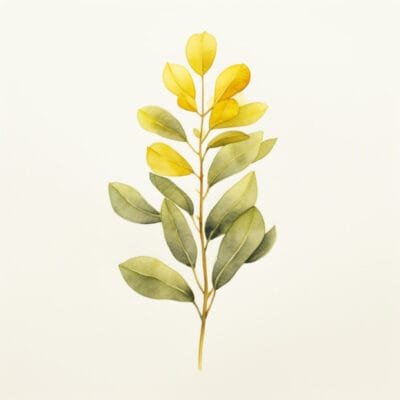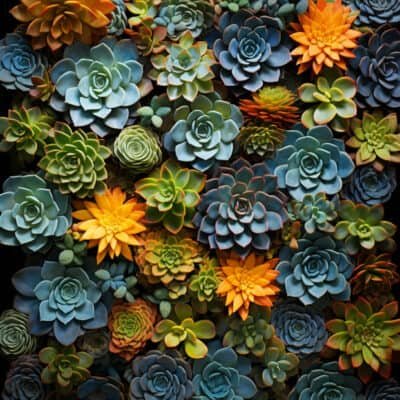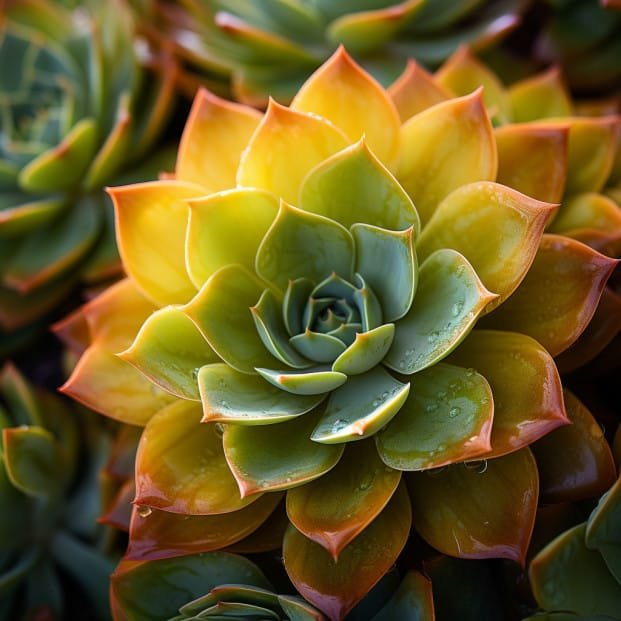Succulent leaves turning yellow may be caused by plant troubles such as watering issues, light issues, etc.
But, don’t assume the worst just yet!
As a lifelong succulent enthusiast, I’ve seen my share of yellowing leaves over the years.
At first glance, a sad yellow leaf makes it easy to worry that your plant is sick or struggling.
However, in many cases some yellow leaves are totally normal and nothing to fret over.
Before rushing to solutions, let me share a few things I’ve learned about what’s really going on below the soil.
Keep reading to discover whether your succulents really have a problem, or if their coloring is perfectly natural.
You’ll also get my best tips for telling the difference, which succulent owners of all experience levels can benefit from.
KEY TAKEAWAY
Succulent leaves turning yellow, what to know?
Succulent leaves turning yellow can be a sign of stress, overwatering, or nutrient deficiencies. (1)
Addressing these issues promptly is crucial for your succulents’ health and appearance.
Understanding the Causes of Yellow Succulent Leaves
There are several reasons why succulent leaves may turn yellow.
A change in the color of leaves on succulents can sometimes indicate a problem with the plant’s health.
It’s crucial to understand the potential causes of yellow succulent leaves, so you can properly care for your collection of these drought-tolerant plants.
Let’s take a closer look at some common reasons for the leaves losing their green hue:
Too much or too little water are both potential culprits.
Overwatering can cause root rot by leaving the soil saturated for extended periods.
Underwatering may cause the plant stress and an inability to uptake necessary water and nutrients.
Light exposure that’s too intense or inadequate could also impact the leaves.
Too much sun may scorch and discolor them, while too little light leads to stretching and bleaching.
Pests like mealybugs, spider mites, or scale feeding on plant tissues can weaken a succulent and lead to yellowing.
Identifying and addressing any infestations early is important.
Nutrient deficiencies from poor soil quality or drainage issues may also play a role.
Ensuring succulents have soil that drains well and contains essential minerals is key.
Environmental factors such as temperature extremes, prolonged low humidity levels, or wounds and diseases could cause challenges too.
Maintaining optimal growing conditions prevents unnecessary stress.
Taking time to carefully observe plants for issues like overwatered roots or nutritional imbalances helps narrow down the potential explanations for why leaves lose their healthy green appearance.
Capturing the causes of yellowing is half the battle in keeping succulents in peak condition.
Overwatering: Common Culprit Behind Yellow Leaves

One of the most common causes of yellow succulent leaves is overwatering. (2)
Succulents like sandy, fast-draining soil with good drainage.
They do not like wet feet.
If the soil stays saturated for too long after a watering, it can cause root rot.
Rotten roots cannot absorb enough nutrients and water from the soil.
The leaves then start to turn yellow.
Some signs that overwatering may be the cause of yellow leaves include slimy or mushy stems.
The stem will start to turn transparent, and eventually fall off from the plant.
You’ll also notice the yellow leaves spreading from the bottom of the plant upwards.
The plant may even start to smell rotten.
Too frequent waterings and poor drainage are usually to blame.
You can prevent overwatering by using a well-draining soil mix with ingredients like perlite or sand.
This allows excess water to drain out of the drainage hole.
Only water when the top inch of soil is completely dry.
Make sure your pot has an unglazed drainage hole so water can escape.
Checking soil moisture with your finger is a smart way to monitor your succulent plants’ needs.
It’s also important to consider how much sunlight your succulent receives.
Those that get a lot of direct rays may dry out faster between waterings.
Pay attention to growth rates too.
Succulents potted individually usually only need water every 2-3 weeks.
Those clustered together in the same pot may need it slightly more often.
Err on the side of less water vs more to avoid root rot from excess water.
Keeping a watchful eye out for pests like mealybugs or scale is also key.
An infestation can weaken a plant and contribute to yellow leaves.
Ensure conditions like light and temperature are ideal.
With the right care, your succulents should stay healthy and colorful for many years to come.
Identifying causes of yellow leaves is the first step to prevention.
Underwatering and its Effects on Succulent Leaves
Neglecting to water the succulents is another common mistake beginning succulent owners make.
While overwatering causes root rot, underwatering has its own problems.
When succulents do not receive enough water, their leaves may begin to turn yellow too.
Succulents still need water to perform important processes like nutrient absorption.
When the soil stays too dry, succulents can develop nutrient deficiencies since their roots cannot uptake the nutrients they need.
Without proper hydration, succulent leaves may lose their vivid green colors and start to appear faded and dried out.
They’ll sometimes develop transparent or wrinkled patches too.
Underwatering succulents places them under undue stress.
Prolonged dry soil puts succulents in survival mode and halts normal growth.
Give indoor succulents a thorough drink about once every 1-2 weeks depending on moisture and temperature where they’re located.
Outdoor plants in dry climates may need it even more regularly during the warm season.
Sunlight Matters: How Light Affects Succulent Health

Just like water, the right amount of light is critical for succulent well-being.
Most succulents need at least 6 hours of direct sunlight daily to stay healthy and prevent leaves yellow.
However, too much intense light without acclimating can easily burn foliage.
Plants sold as “low-light” still require bright, indirect light to thrive.
Succulents etiolate or become leggy when reaching for more sun.
Their compact forms may stretch out with thinner leaves and paler colors.
This is because low-light induces them to grow taller to reach the sun above.
Be aware of changing light levels throughout the year and as succulents mature.
Rotate pot locations or supplement with grow lights as needed.
Carefully monitoring light exposure helps avoid underwatering due to moisture loss or sun scorching sensitive leaves.
With access to balanced sun and hydration, leaves will remain lush and magnificent for longer.
Dealing with Root Rot in Succulents
One of the unfortunate outcomes of overwatering succulents is root rot.
When soil stays saturated for too long, the conditions are perfect for fungi and bacteria to break down roots.
Root rot can cause leaf yellowing and may even kill the plant if left untreated.
The first sign of root rot is usually mushy, brown roots.
You may also notice leaves looking less firm and spots starting as yellow patches.
Catching it early is key.
To save an infected succulent, carefully remove it from the pot.
Gently shake off as much old soil as possible.
Severely rotted roots can be pruned away with sterilized shears.
Repot the succulent in fresh, well-draining soil mixed with perlite, gravel or sand for improved drainage.
Water minimally until new roots develop.
Increased humidity and stagnant moisture from poor ventilation or overcrowding can also enable root rot.
Increased airflow and drainage helps prevent this issue.
Pest Infestations and Yellowing Leaves

Along with cultural errors, pests are another common culprit behind succulent foliage turning yellow.
Common indoor pests to watch out for include spider mites, mealybugs, and scale.
These sap-sucking insects weaken plants through feeding damage.
Looking closely, you may spot tiny spider mites, cottony mealybugs, or hard scale insects on leaves and stems.
During infestations, stippling or spotting may appear on succulent leaves.
Symptoms can resemble nutrient deficiency at first.
Over time if left untreated, whole leaves or a plant’s foliage may yellow and drop off.
Isolate and address any suspect plants promptly using organic or commercially registered remedies.
Continued monitoring and prevention helps minimize stress from pests.
By catching causes early and taking corrective action, it’s quite possible to restore succulents’ lush green color.
Soil Quality and Drainage: Impact on Succulent Leaves
The type of soil used for succulents makes a big difference in their health and appearance.
Succulents have very specific soil needs compared to other houseplants.
A good soil mix for succulents should contain fast-draining materials like perlite, vermiculite, coarse sand, gravel or small rocks for drainage.
This allows excess water to quickly drain away from roots.
Poorly draining, overly soggy or damp soil leaves no room for dry soil between waterings.
Succulent roots sitting in soggy soil are more prone to root rot and other issues.
Leaves may start off looking wilted or translucent before turning yellow and dead leaves.
A good succulent soil should contain a combination of potting soil and gritty additives for improved structure.
Place succulents in pots with drainage hole to further prevent wet feet.
Cactus or succulent-specific potting mixes sold at stores also promote drainage and growth.
Check soil conditions regularly to understand your plants’ needs and avoid yellow leaves from sour soil.
Nutrient Deficiency and Yellowing Succulent Leaves
Besides overwatering, underwatering and pests, nutrient deficiency is another culprit behind yellow leaves in succulents.
Symptoms can vary based on which nutrient is lacking.
Yellow or pale leaves may indicate a need for certain vitamins or minerals.
While succulents are fairly resistant plants overall, they still require certain amounts of nitrogen, phosphorus, and potassium, and a balanced mix of microbes.
Leaves may turn yellowish from iron deficiency or white from chlorosis caused by lack of magnesium.
Applying an all-purpose water soluble fertilizer once a month during growing seasons top-dresses these important nutrients back into the soil.
Or use a monthly cactus/succulent fertilizer according to label rates to keep healthy green pigment in leaves year-round.
This prevents deficiencies that cause stress and color loss.
Common Questions About Succulent Leaves Turning Yellow
Is wet soil bad for succulents?
Yes, wet soil is harmful for succulents.
Succulent roots require well-draining soil that dries out between waterings.
Wet soil staying saturated for long periods of time can cause root rot in succulents.
What type of soil is best for succulents?
A gritty succulent soil mixture works well.
Succulent soil should contain ingredients like perlite or sand for drainage and airflow around roots.
This prevents wet feet that can damage succulent plants.
How do I care for indoor succulent plants?
Indoor succulents need bright, indirect light and infrequent watering.
Check soil moisture frequently and only water when dry.
Ensure potting containers have drainage holes to prevent root issues from overwatering inside.
How often should I water succulent plants?
Watering frequency varies depending on the type of succulent and growing conditions.
As a general rule, watering every 7-10 days in spring/summer, allowing the soil to dry between watering sessions, is adequate for most succulents.
What causes yellow spots on succulent leaves?
Yellow spots on succulent leaves can indicate issues like overwatering, underwatering, nutrient deficiency, or pests.
Close observation helps identify the cause so the proper care adjustments can be made to remedy the spots and stress.
How long does it take for a stressed succulent to recover?
Stressed succulents may take weeks or months to fully recover, depending on the type and severity of stress.
Be patient and observe for new healthy growth as a sign the succulent is rebounding from a challenging period of time.
What fertilizer is good for succulents?
A balanced liquid water-soluble fertilizer used monthly during the growing seasonboosts succulents’ nutrient levels when applied per label directions.
Look for a complete formulation suitable for cacti and succulents.
How can I move a succulent to a brighter location?
Gently transplant succulents to sunnier spots outdoors as needed for optimum light exposure.
Provide acclimation time if moving between indoor vs outdoor conditions to prevent sunburn on leaves.
Snip off damage or propagation new plants from leaves and stems.
What causes a succulent’s leaves to fall off?
Leaves dropping can indicate stress from issues like overwatering, underwatering, pests, Temperature/light changes or other cultural errors.
Addressing the underlying cause helps encourage new leaf growth while the succulent’s overall health rebounds through a stress response.
How do I know if my succulent is dying?
Signs a succulent is declining include leaves falling off, mushy stems, pale yellow or translucent coloration spreading across most of the plant.
Catching problems early improves chances of recovery through correct care adjustments.
Severely ill succulents may need to be removed before disease spreads.
What types of succulents are easiest to care for?
Hearty succulents tolerant of varied conditions include jade plant, aloe vera, echeveria, haworthia and snake plant.
These “set it and forget it” types thrive with infrequent watering in average, brightly lit indoor areas.
How do I save an entire succulent plant?
To salvage a whole succulent showing health issues, remove it gently from the pot.
Trim away rotted roots/sections, allow cut areas to callus, then replant in fresh succulent soil mix.
Monitor drainage and watering routine closely until new growth appears.
What types of plants do succulents go well with?
Succulents pair beautifully with other drought-tolerant plants like cacti, peperomia, sansevieria and pothos.
Their varied leaf textures create visual interest together on patios or prominent display inside the home.
Do I need special potting soil for succulents?
Yes, using a succulent and cactus potting mix designed for fast drainage is recommended over general houseplant soils.
Look for a premixed, soil-based potting mix containing perlite or similar additives for succulents’ aeration requirements.
What is the proper watering routine for succulents?
Allow succulent soil to dry fully between waterings, about 1-2 weeks depending on conditions.
Water thoroughly until excess runs from the drainage holes, then discard any standing water that collects in saucers for pots.
How do I prevent overwatering succulents?
Signs of overwatering include yellowing lower leaves and mushy stems at the soil line.
Use well-draining soil, avoid frequent small waterings, provide adequate light/airflow and only water when soil is dry 1-2 inches deep to minimize root rot risks.
What is the ideal frequency for watering succulents?
On average, watering every 7-10 days during spring/summer growth peaks suits most succulents.
Frequency may vary slightly based on container size/material, light exposure and indoor vs. outdoor placement.
Consistent moisture level monitoring optimizes care.
How can I tell if I’m watering my succulents correctly?
Healthy succulents display plump, firm leaves and dry soil between waterings.
Over time, observe the soil dries 1-2 inches down within a week to 10 days.
Make adjustments if you notice yellowing lower foliage or soggy potting mix indicating too much/frequent water applications.
Conclusion
Before you go…
I hope this guide has helped take some of the mystery and worry out of yellow succulent leaves.
As planting season approaches, be on the lookout for my next article where I’ll share my favorite varieties of succulents that hold their vibrant colors longest.
Get a jump start on your spring and summer gardens by picking plants you know will look their best all season long.
Until next time, keep your green thumb green!
References
- https://www.epicgardening.com/succulent-discolored/
- https://grow.ifa.coop/gardening/8-reasons-plant-leaves-turn-yellow#:~:text=Overwatering,%E2%80%9Cunder%20aired%E2%80%9D%20and%20suffocating.
Related Articles
- https://knowngarden.com/plants-turning-yellow/
- https://knowngarden.com/yellow-leaves-on-snake-plant/
- https://knowngarden.com/why-are-my-hydroponic-plants-turning-yellow/

